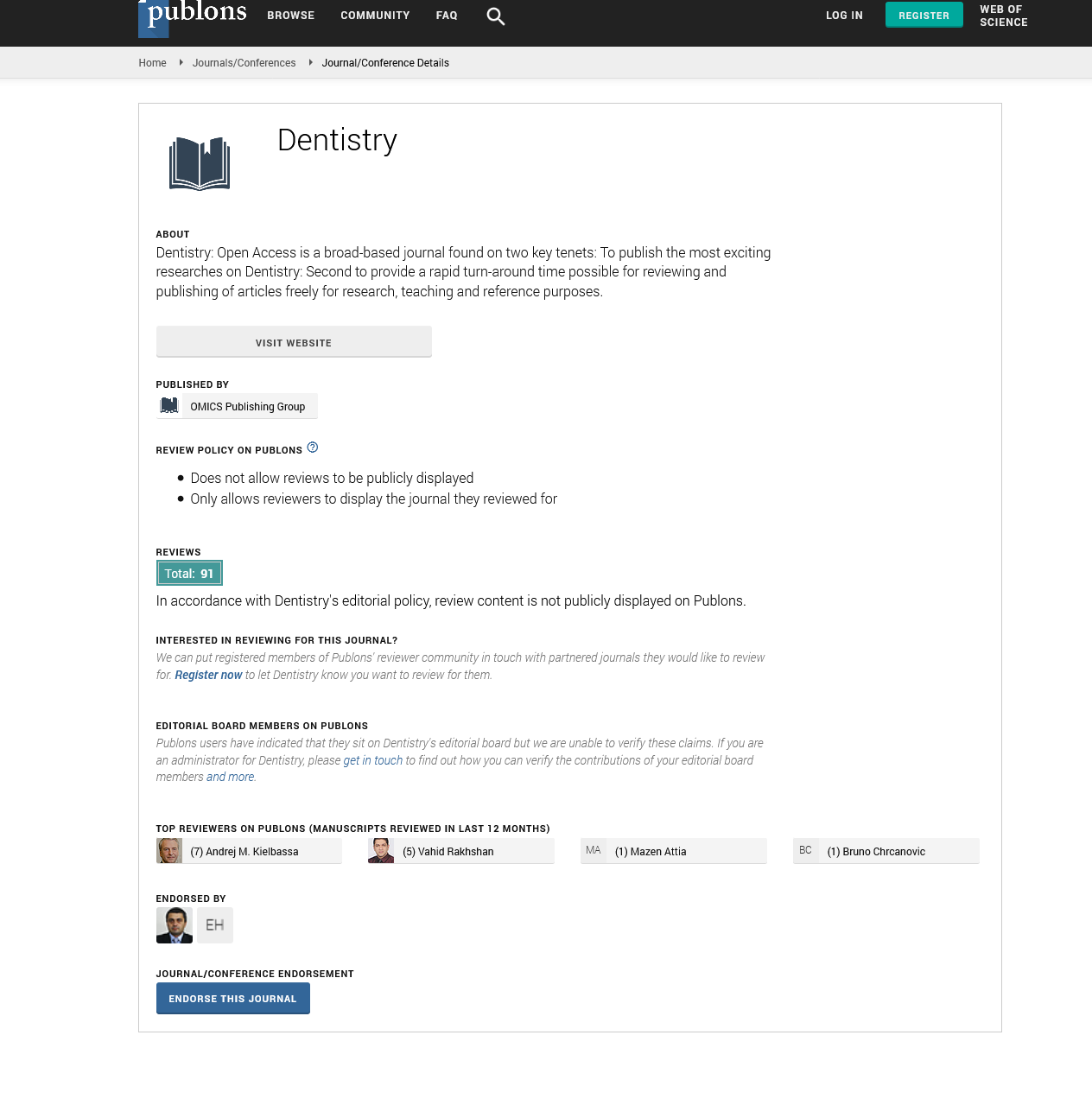Citations : 2345
Dentistry received 2345 citations as per Google Scholar report
Indexed In
- Genamics JournalSeek
- JournalTOCs
- CiteFactor
- Ulrich's Periodicals Directory
- RefSeek
- Hamdard University
- EBSCO A-Z
- Directory of Abstract Indexing for Journals
- OCLC- WorldCat
- Publons
- Geneva Foundation for Medical Education and Research
- Euro Pub
- Google Scholar
Useful Links
Share This Page
Journal Flyer

Open Access Journals
- Agri and Aquaculture
- Biochemistry
- Bioinformatics & Systems Biology
- Business & Management
- Chemistry
- Clinical Sciences
- Engineering
- Food & Nutrition
- General Science
- Genetics & Molecular Biology
- Immunology & Microbiology
- Medical Sciences
- Neuroscience & Psychology
- Nursing & Health Care
- Pharmaceutical Sciences
Commentary Article - (2024) Volume 14, Issue 4
Enhancing Quality of Life through Digital Dentistry Innovations
Myroslav Schwendicke*Received: 25-Nov-2024, Manuscript No. DCR-24-27041; Editor assigned: 27-Nov-2024, Pre QC No. DCR-24-27041 (PQ); Reviewed: 11-Dec-2024, QC No. DCR-24-27041; Revised: 18-Dec-2024, Manuscript No. DCR-24-27041 (R); Published: 26-Dec-2024, DOI: 10.35248/2161-1122.24.14.708
Description
Digital dentistry has revolutionized the field of oral health by integrating advanced technology into diagnostic and treatment procedures. This transformation has not only improved clinical outcomes but also significantly influenced patients' quality of life. This article explains how digital dentistry enhances oral health- related quality of life through various technological advancements.
Understanding digital dentistry
Digital dentistry encompasses a range of technologies that use digital tools and techniques to improve dental care. These include digital imaging, Computer-Aided Design and Manufacturing (CAD/CAM), digital impressions and more. By moving from traditional methods to digital processes, the field of dentistry has seen notable improvements in accuracy, efficiency and patient comfort.
Key technologies in digital dentistry
Digital imaging: Digital imaging technologies, such as digital radiography, replace traditional X-rays with electronic sensors. These sensors capture images that are processed and displayed on computer screens.
Computer-Aided Design and Manufacturing (CAD/CAM): CAD/CAM technology allows for the design and creation of dental restorations, such as crowns and bridges, using computer software and milling machines.
Digital impressions: Digital impression systems use intraoral scanners to create 3D images of a patient's teeth and oral structures.
Laser dentistry: Lasers are used for various dental procedures, including soft tissue surgeries and teeth whitening.
Impact on oral health-related quality of life
Oral Health-Related Quality of Life refers to how oral health conditions affect an individual's overall quality of life. This includes aspects such as comfort, function and appearance.
Enhanced diagnostic accuracy and treatment outcomes
Improved diagnosis: Digital imaging and diagnostic tools provide clearer and more accurate images of dental structures. This enhances the ability to detect issues early, leading to more effective treatment and prevention of complications.
Precise treatment planning: Technologies like CAD/CAM and digital impressions facilitate precise planning and execution of treatments. This precision reduces the likelihood of errors and improves the fit and functionality of restorations.
Increased patient comfort and convenience
Reduced discomfort: Digital impression systems and laser technologies often cause less discomfort compared to traditional methods. This improves the patient experience during procedures.
Faster treatment times: CAD/CAM systems and digital workflows can reduce the time needed for dental procedures and restoration fabrication. This results in fewer appointments and shorter waiting times for patients.
Enhanced aesthetic outcomes
Better aesthetics: The accuracy and customization afforded by digital tools contribute to superior aesthetic results in dental restorations. This can positively affect patients' self-esteem and satisfaction with their appearance.
Improved functionality
Better fit and function: Digital technologies allow for more precise restorations that fit better and function more effectively. This can enhance patients' ability to chew, speak and perform other oral functions comfortably.
Streamlined workflow
Efficiency in procedures: Digital workflows often streamline processes, reducing the need for repetitive steps and minimizing potential errors. This efficiency benefits both the dental team and the patients, leading to smoother experiences and quicker recovery times.
While digital dentistry offers numerous advantages, there are challenges and considerations to keep in mind.
Cost of technology
Investment: Digital tools and technologies can require significant investment. The cost of acquiring and maintaining these technologies may be a barrier for some practices and patients.
Training and adaptation
Learning curve: Dental professionals need to be adequately trained to use digital technologies effectively. Adapting to new systems and workflows can require time and effort.
Data security
Confidentiality: With the digital storage and transmission of patient data, ensuring data security and patient confidentiality is essential. Practices must adhere to regulations and implement.
Technology reliability
Technical issues: Digital systems may encounter technical issues or malfunctions, which can disrupt procedures. Having contingency plans and technical support is important to mitigate these risks.
The field of digital dentistry is continuously evolving, with ongoing research and development aimed at enhancing technology and improving patient care. Future advancements may include:
Integration of artificial intelligence
AI in diagnosis: Artificial Intelligence (AI) has the potential to further enhance diagnostic accuracy by analyzing digital images and data to identify patterns and predict treatment outcomes.
Advancements in materials
New materials: The development of advanced materials for digital restorations may lead to even better performance and aesthetics, further benefiting patients' oral health-related quality of life.
Expansion of remote monitoring
Tele-dentistry: Remote monitoring and tele-dentistry solutions could provide greater access to care and enable more convenient follow-up and consultation options for patients.
Citation: Schwendicke M (2024). Enhancing Quality of Life through Digital Dentistry Innovations. J Dentistry. 14:698.
Copyright: © 2024 Schwendicke M. This is an open-access article distributed under the terms of the Creative Commons Attribution License, which permits unrestricted use, distribution, and reproduction in any medium, provided the original author and source are credited.

